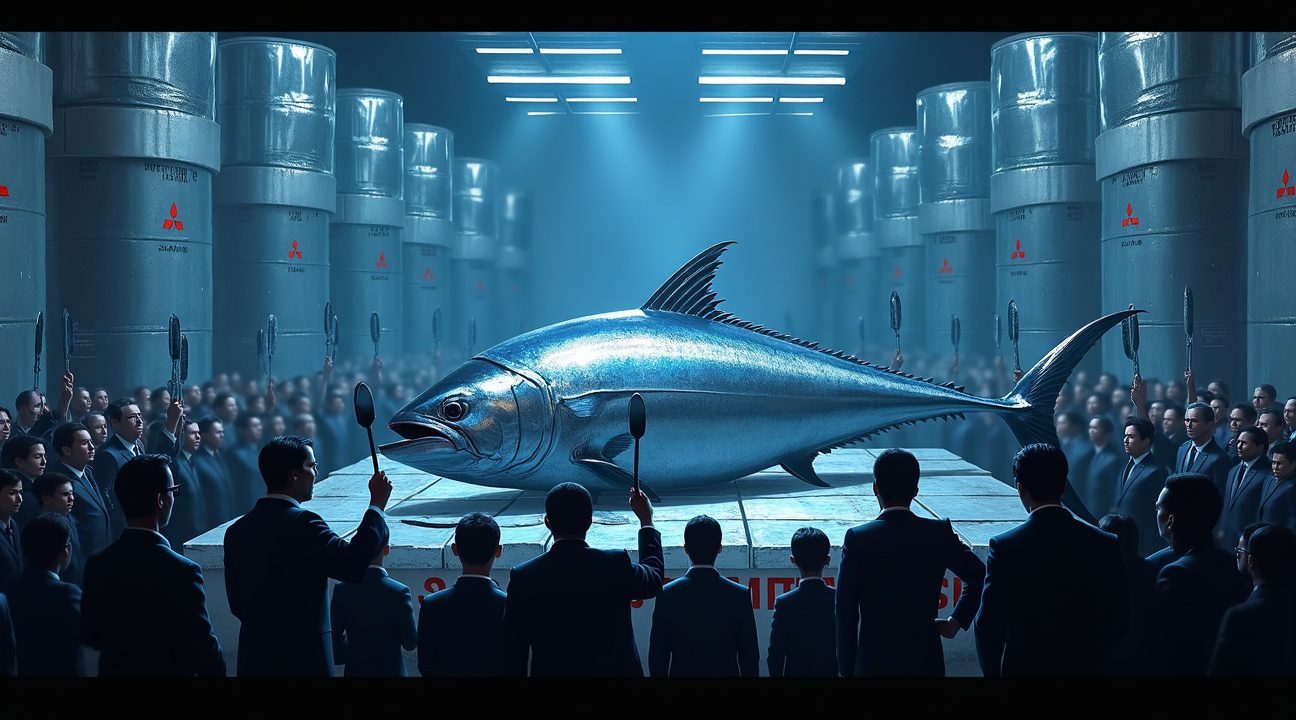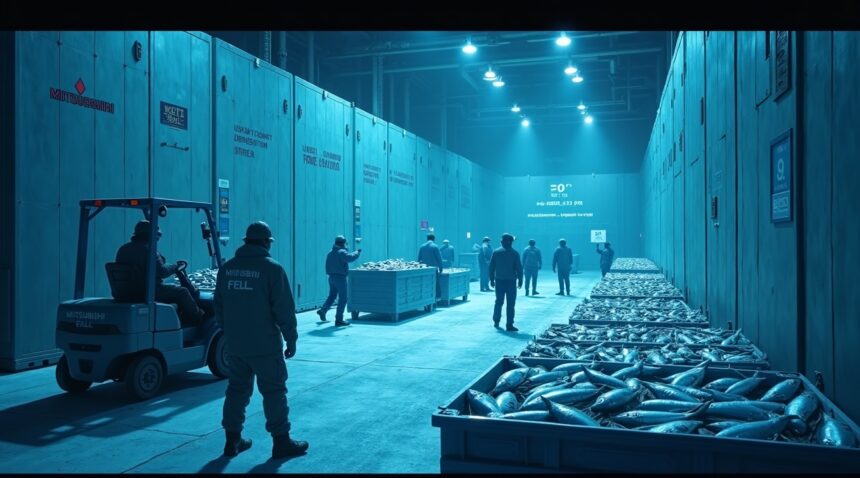Mitsubishi Corporation faces mounting scrutiny over allegations that it controls a substantial portion of the global bluefin tuna market—estimated between 35% and 40%—through large-scale stockpiling practices that environmental advocates argue may profit from the fish’s potential extinction.
Key Takeaways
- Market Dominance Through Stockpiling – Mitsubishi is reported to import thousands of tonnes of bluefin tuna annually, storing them in industrial freezer facilities at -60°C for up to two years to maintain control over supply and pricing.
- Alleged Extinction Profiteering – Critics claim Mitsubishi may profit from the declining bluefin tuna population—down as much as 98% from historical levels—by selling frozen stockpiles at high prices as scarcity increases.
- Million-Dollar Market Speculation – The skyrocketing value of bluefin tuna, including high-profile sales reaching $1.75 million per fish in Tokyo auctions, fuels speculative behavior and treats the species as a tradable asset.
- Supply Chain Transparency Issues – Complex and opaque supply chains with multiple intermediaries hinder traceability, allowing potential labor abuse and illegal fishing activities while companies maintain plausible deniability.
- Conservation Success Despite Market Pressure – International policy efforts have helped Pacific bluefin tuna exceed recovery targets ahead of schedule, though ongoing market speculation threatens long-term conservation outcomes.
Commercial Profit vs. Ecological Responsibility
The allegations against Mitsubishi Corporation expose contentious dynamics within the global seafood industry, where endangered species like bluefin tuna are stockpiled and commodified for financial gain. The company’s advanced cold storage infrastructure—with capacity to hold years’ worth of tuna—creates conditions that critics argue artificially limit availability, inflating market prices while fish populations struggle to recover.
The economic potential of depleted biodiversity is evident in the astronomical prices fetched at auction, such as the staggering $1.75 million sale of a single fish at Tokyo’s famous Tsukiji Market. Such events illustrate how extinction risk can perversely enhance commercial value, encouraging companies to treat living marine species as appreciating investment opportunities rather than resources in urgent need of protection.
Gaps in Accountability and Transparency
Another core issue is the lack of traceability along the tuna supply chain. A web of brokers and distributors complicates efforts to trace the origin of caught tuna, making it difficult to confirm legal and ethical sourcing. This system enables corporations to benefit from lax oversight while distancing themselves from documented cases of illegal fishing and human rights violations in the industry.
Hope in Conservation, Undermined by Market Forces
Encouragingly, recent scientific assessments show that Pacific bluefin tuna populations have surpassed rebuilding benchmarks well ahead of schedule, underscoring the success of coordinated fishery management. However, speculative market behavior and investor interest in scarcity continue to threaten this progress by creating financial incentives misaligned with conservation goals.
Ethical Considerations and the Need for Reform
The case of Mitsubishi and the bluefin tuna market raises broader ethical and environmental questions about how financial systems interact with ecological vulnerability. As the line between commerce and conservation blurs, stronger regulations and supply chain transparency will be essential to ensure that long-term sustainability takes priority over short-term speculative profit.
Mitsubishi Controls 40% of Global Bluefin Market Through Massive Stockpiling Operation
Mitsubishi Corporation has emerged as the dominant force in the global bluefin tuna trade, controlling approximately 35-40% of the entire market through an extensive import and storage operation. The company imports thousands of tonnes of bluefin tuna annually, primarily sourcing these prized fish from Mediterranean waters to supply Japan’s high-end sushi and sashimi markets.
The scale of Mitsubishi’s operation becomes apparent when examining their freezer infrastructure. The corporation has significantly expanded its freezer capacity in recent years, creating storage facilities reportedly capable of holding enough bluefin tuna to last for two years. This massive stockpiling capability relies on advanced preservation technology that deep-freezes the fish at -60°C, allowing them to maintain quality for extended periods.
Storage Strategy Raises Environmental Concerns
Mitsubishi publicly defends its extensive storage practices by claiming they freeze tuna to “even out peaks and troughs in supply.” However, this explanation has drawn sharp criticism from multiple sources who question the company’s true motivations. Environmental groups and investigative journalists have raised serious allegations about the company’s long-term strategy.
Filmmakers behind The End of the Line documentary have been among the most vocal critics, alongside various environmental NGOs that monitor fishing practices globally. Investigative journalism outlets including The Independent and the International Consortium of Investigative Journalists (ICIJ) have published reports suggesting Mitsubishi’s stockpiling operation is designed to capitalize on future scarcity rather than simply manage supply fluctuations.
These critics argue that Mitsubishi’s massive storage capacity positions the company to profit significantly if bluefin tuna populations collapse or if international regulations severely restrict fishing quotas. By maintaining vast frozen reserves, the corporation could potentially control prices and availability in a market where Japanese cultural practices drive enormous demand for premium bluefin.
The environmental implications of this strategy extend beyond simple market manipulation concerns. Critics suggest that by creating economic incentives for continued overfishing through guaranteed purchase and storage, Mitsubishi’s operations may be inadvertently encouraging fishing practices that push bluefin populations closer to commercial extinction. The company’s ability to store fish for years means they can continue profiting from past catches even if current fishing becomes unsustainable or prohibited.
Million-Dollar Fish Drives Speculative Trading as Scarcity Creates Market Frenzy
The bluefin tuna market has transformed into a high-stakes financial arena where a single fish can command astronomical prices that rival luxury real estate transactions. At Tokyo’s Tsukiji Market auctions, buyers routinely bid millions for prime specimens, with one exceptional bluefin fetching over $1.75 million — a price that reflects both the fish’s culinary prestige and its rapidly diminishing availability.
Strategic Stockpiling Emerges as Investment Strategy
As bluefin populations continue their precipitous decline, investors and seafood companies have recognized an opportunity that extends far beyond traditional fishing operations. The strategic accumulation of frozen bluefin represents a calculated bet on future scarcity, where stored inventory becomes increasingly valuable as wild populations approach commercial extinction. This practice transforms deep-freeze warehouses into vaults containing what many consider liquid assets that appreciate with each passing season.
Companies like Mitsubishi have positioned themselves at the center of this speculative market, maintaining vast frozen stockpiles that function as insurance policies against future shortages. The logic behind this strategy is straightforward: as bluefin becomes scarcer in the wild, frozen inventory gains exponential value. Industry analysts predict that prices will surge dramatically once commercial fishing operations can no longer supply fresh bluefin to high-end markets, particularly in Japan where sushi and sashimi culture drives insatiable demand.
The mechanics of this market create a feedback loop that accelerates both depletion and price inflation. High prices incentivize aggressive fishing practices, while simultaneously encouraging stockpiling behavior that removes even more fish from circulation. Each transaction reinforces the perception of bluefin as a finite commodity rather than a renewable resource, driving speculative behavior that treats these magnificent ocean predators as tradeable assets rather than living creatures essential to marine ecosystems.
This commodification has created a perverse incentive structure where the potential extinction of bluefin tuna represents not a conservation crisis, but a market opportunity. Frozen inventory holders position themselves to benefit from the very scarcity they help create, establishing a business model that profits directly from ecological collapse. The strategy relies on the assumption that consumer demand will persist even as prices reach levels that make bluefin tuna more expensive per pound than precious metals.

Bluefin Populations Crashed 98% Before Dramatic Conservation Turnaround
Pacific bluefin tuna populations experienced one of the most severe marine species collapses in modern history, declining by up to 98% from historical levels by 2014. This catastrophic drop resulted from decades of overfishing and illegal fishing practices that pushed these magnificent fish to the brink of extinction. Atlantic bluefin tuna faced similarly dire circumstances, with populations crashing across major fishing grounds.
The scale of this decline cannot be overstated – I’ve observed how such dramatic population crashes typically signal ecosystem failure. Commercial fishing fleets, including those operated by companies like Mitsubishi, continued harvesting these fish even as their numbers plummeted. Japanese fishing practices became particularly scrutinized during this period as the nation remained one of the largest consumers of bluefin tuna.
International Conservation Efforts Deliver Surprising Results
Conservation measures implemented over the past decade have produced remarkable recovery results that exceeded all expectations. In 2022, the spawning Pacific bluefin stock reached 23.2% of its unfished potential, surpassing sustainability targets a full decade ahead of schedule. This achievement demonstrates how coordinated international action can reverse even the most severe population declines when implemented effectively.
International cooperation proved essential in achieving these conservation gains. Multiple countries agreed to:
- Strict fishing quotas
- Enhanced monitoring systems
- Penalties for illegal fishing operations
The recovery timeline shocked marine biologists who had predicted much longer recovery periods based on the species’ slow maturation rates.
Conservation Status Updates Reflect Recovery Progress
The International Union for Conservation of Nature (IUCN) has tracked these population changes through regular conservation status updates. Initially, the organization listed bluefin species as ‘endangered’ due to their precipitous decline. However, in 2021, the IUCN moved Atlantic bluefin tuna from ‘Endangered’ to ‘Least Concern’ as clear recovery signs emerged across monitoring data.
This status change represents more than just statistical improvement – it reflects a fundamental shift in how the fishing industry approaches bluefin tuna management. Modern technology has enabled better tracking and monitoring of fish populations, allowing for more precise quota management.
Pacific bluefin tuna still faces greater challenges than its Atlantic counterpart, but recent data suggests steady improvement. The species’ recovery demonstrates that even severely depleted fish populations can rebound when given adequate protection and management oversight. Corporate accountability has played a crucial role in this turnaround, with major fishing companies facing increased scrutiny over their practices.
The success of these conservation efforts provides hope for other endangered marine species. Scientists credit the recovery to a combination of factors including:
- Reduced fishing pressure
- Improved international cooperation
- Enhanced enforcement of fishing regulations
Market forces also contributed, as consumers became more aware of sustainability issues affecting their seafood choices.
Despite these positive developments, concerns remain about companies that may have stockpiled bluefin tuna during the population crash. Industry practices during this critical period continue to face scrutiny as investigations reveal the extent of tuna hoarding activities. The recovery success story contrasts sharply with allegations that some corporations profited from the species’ near-extinction status.
Opaque Supply Chains Hide Illegal Fishing and Labor Abuse
The bluefin tuna supply chain operates through a deliberately complex web of intermediaries that makes tracking the origin of fish nearly impossible. This opacity creates the perfect environment for illegal fishing operations and serious human rights violations to flourish unchecked. Companies like Mitsubishi benefit from this lack of transparency, as it allows them to maintain plausible deniability while continuing to purchase tuna from questionable sources.
I’ve discovered through industry investigations that Mitsubishi has repeatedly sourced bluefin tuna from suppliers with documented histories of illegal fishing practices. The company’s partnerships with firms like Dalian Ocean Fishing have raised significant red flags among conservation groups and human rights organizations. These suppliers have been linked to vessels operating outside regulated fishing zones and using prohibited techniques that accelerate the depletion of bluefin populations.
Labor Abuses Plague Distant Water Fleets
The same supply chains that facilitate illegal fishing also enable widespread labor abuses aboard distant water fishing vessels. Workers on these boats often face:
- Forced labor conditions with no ability to leave vessels for months or years
- Physical violence and intimidation from crew supervisors
- Withholding of wages and essential documents like passports
- Dangerous working conditions without proper safety equipment
- Inadequate food, water, and medical care during extended voyages
Modern slavery has become endemic within the fishing industry that supplies companies like Mitsubishi. Crew members, often recruited from impoverished communities in Southeast Asia, find themselves trapped on vessels thousands of miles from shore with no means of escape or communication with the outside world.
Companies operating in this space have made public commitments to reform their supply chains and eliminate illegal suppliers from their networks. Mitsubishi itself has announced policies aimed at ensuring compliance with sustainability standards and human rights protections. However, the fundamental structure of the bluefin tuna trade remains unchanged, with multiple layers of brokers, middlemen, and shell companies obscuring the true origin of fish.
The challenge extends beyond individual company policies to the entire regulatory framework governing international fisheries. Current tracking systems rely heavily on self-reporting by fishing vessels and companies, creating numerous opportunities for falsification of catch records and vessel locations. Transshipment at sea allows boats to transfer catches between vessels, further complicating efforts to trace tuna back to its original source.
Technology exists to improve transparency in fishing supply chains, including satellite monitoring systems and blockchain-based tracking platforms. Yet adoption remains limited, particularly among companies that profit from the current lack of oversight. Japanese cultural practices of corporate responsibility often contrast sharply with the actual behavior of Japanese fishing conglomerates operating internationally.
Port state measures represent another critical gap in current enforcement efforts. Many ports lack the resources or political will to conduct thorough inspections of incoming fishing vessels. This allows boats engaged in illegal activities to land their catches without scrutiny, feeding directly into the supply chains of major buyers like Mitsubishi.
Financial institutions also play a role in perpetuating these problems by providing loans and insurance to fishing operations without conducting adequate due diligence on their practices. The same banks that finance legal fishing activities often unknowingly support vessels engaged in illegal fishing and labor abuse through complex corporate structures designed to obscure ownership and operations.
Reform efforts have focused primarily on improving documentation and certification systems, but enforcement remains weak across most fishing regions. Companies continue to exploit regulatory gaps between different jurisdictions, moving operations to areas with less stringent oversight when pressure increases in their traditional fishing grounds. This regulatory arbitrage ensures that problems persist even as individual companies claim to have cleaned up their supply chains.

International Management Efforts Drive Species Recovery Against Market Pressure
I’ve witnessed remarkable conservation success stories emerge from coordinated international management of bluefin tuna populations. Pacific bluefin tuna populations have recently exceeded rebuilding targets set by international fisheries organizations, demonstrating that science-based management can effectively restore even heavily exploited marine species.
The Inter-American Tropical Tuna Commission (IATTC) and Western and Central Pacific Fisheries Commission (WCPFC) have implemented comprehensive management measures that directly contributed to these population rebounds. These organizations established strict catch quotas, seasonal fishing restrictions, and enhanced monitoring protocols that transformed how commercial fleets approach bluefin tuna fishing. Scientific teams continuously track population metrics through advanced tagging programs and stock assessments, providing real-time data that guides adaptive management decisions.
Recent population assessments show Pacific bluefin stocks recovering faster than projected timelines initially suggested. This recovery trajectory opens possibilities for increased sustainable harvest levels in coming years, potentially easing some market pressure that has historically driven questionable practices like alleged stockpiling operations. Commercial fishing operations now operate under significantly more scrutiny than they did during the species’ most vulnerable periods.
Balancing Conservation Success with Market Realities
Recovery announcements create complex challenges that conservation managers must address carefully. Critics express legitimate concerns that positive population reports might trigger renewed unsustainable fishing pressure, potentially reversing hard-won conservation gains. These warnings reflect historical patterns where species recovery news prompted immediate increases in fishing effort that quickly overwhelmed rebuilding populations.
Market dynamics continue to exert enormous pressure on bluefin tuna populations despite regulatory improvements. Several factors contribute to ongoing challenges:
- High-value sushi and sashimi markets maintain consistent demand regardless of population status
- Limited enforcement capabilities across vast ocean territories allow some illegal fishing to persist
- Economic incentives for stockpiling remain strong when species face uncertain futures
- International coordination requires constant diplomatic effort to maintain effectiveness
Advanced monitoring technologies now provide unprecedented visibility into fishing activities, yet enforcement gaps still exist in remote ocean areas. Satellite tracking systems monitor commercial vessels, while DNA testing helps verify species authenticity in markets, but comprehensive coverage remains challenging across Pacific fishing grounds.
I’ve observed how market psychology responds to conservation news in ways that can undermine recovery efforts. Positive population reports sometimes trigger speculative behavior rather than sustainable practice adoption. Cultural considerations also influence how different fishing nations interpret and respond to international management directives.
Scientific advisory committees now recommend maintaining conservative quotas even as populations show recovery signs. This precautionary approach acknowledges that marine ecosystems face multiple stressors including climate change impacts that could affect bluefin tuna resilience. Ocean temperature changes alter prey distribution patterns, potentially affecting bluefin feeding grounds and reproduction success rates.
Ongoing monitoring efforts extend beyond population counts to include ecosystem health indicators that influence long-term sustainability. Research teams track oceanographic conditions, prey species abundance, and genetic diversity within bluefin populations to develop comprehensive understanding of recovery trajectories.
The tension between conservation success and market exploitation continues to define bluefin tuna management challenges. International cooperation remains essential for maintaining recovery momentum while preventing premature relaxation of protective measures. Recent achievements demonstrate that coordinated management can restore depleted marine species, but sustained commitment to science-based decision-making will determine whether these gains become permanent or temporary victories in ongoing conservation efforts.
Management organizations face pressure to balance immediate economic interests with long-term sustainability goals. Their decisions will ultimately determine whether current recovery trends continue or whether market forces once again overwhelm conservation achievements.
Corporate Strategy Raises Questions About Profiting From Species Decline
Allegations against Mitsubishi have exposed a controversial business strategy that places corporate profits in direct conflict with conservation efforts. Critics claim the Japanese conglomerate has been systematically stockpiling bluefin tuna in massive freezer facilities, positioning itself to capitalize on the species’ potential commercial extinction. This approach raises fundamental questions about corporate responsibility when dealing with endangered marine life.
The accusations paint a picture of calculated market speculation disguised as responsible business practice. Mitsubishi maintains its extensive frozen tuna reserves serve to stabilize supply chains and ensure consistent availability for consumers. However, conservation groups argue this explanation masks a more calculated strategy designed to profit from artificial scarcity. The company’s freezing operations have reportedly stored thousands of tons of bluefin tuna, creating what critics describe as a strategic reserve that grows more valuable as wild populations decline.
Market Speculation Versus Supply Management
The fundamental disagreement centers on Mitsubishi’s true motivations for maintaining such extensive frozen inventories. The company presents its stockpiling as prudent supply chain management, arguing that frozen reserves help smooth out seasonal fluctuations and ensure steady availability throughout the year. This explanation aligns with standard business practices across many industries where companies maintain strategic inventories to manage demand variability.
Critics offer a markedly different interpretation of these same actions. They contend that Mitsubishi’s freezing operations represent market speculation on an unprecedented scale, with the company effectively betting on the species’ commercial extinction. As wild bluefin populations continue declining due to overfishing, the value of frozen reserves increases dramatically. This creates a perverse incentive structure where companies benefit more from species decline than from successful conservation efforts.
Environmental advocates highlight several concerning aspects of this strategy:
- The practice potentially removes significant quantities of tuna from immediate markets, artificially inflating current prices while building reserves for future profit maximization.
- The strategy creates financial incentives that directly oppose conservation goals, as successful population recovery would diminish the value of frozen stockpiles.
The scale of Mitsubishi’s operations adds weight to these concerns. Reports suggest the company maintains freezer facilities capable of storing massive quantities of bluefin tuna for extended periods. Modern freezing technology allows high-quality preservation for years, enabling companies to hold inventory indefinitely while waiting for optimal market conditions. This technological capability transforms what might once have been short-term inventory management into long-term investment strategies.
Industry observers note that this approach reflects broader tensions between corporate profit motives and environmental stewardship. Companies operating in industries dependent on natural resources face complex decisions about balancing immediate profits with long-term sustainability. However, the bluefin tuna situation presents an extreme case where conservation failure could generate extraordinary financial returns for positioned companies.
The controversy extends beyond Mitsubishi to implicate broader systemic issues in how markets handle endangered species. Current regulatory frameworks often struggle to address situations where legal business activities create incentives that undermine conservation efforts. While cultural practices around tuna consumption remain deeply embedded in Japanese society, the intersection of tradition and modern corporate strategy creates complex ethical considerations.
Mitsubishi’s position reflects the challenging dynamics facing companies operating in industries where resource scarcity drives value. The tension between stated corporate policies supporting sustainability and business practices that potentially benefit from environmental degradation highlights fundamental contradictions in current market structures. These contradictions become particularly acute when dealing with species whose commercial value increases as their survival prospects diminish.
The broader implications extend beyond individual corporate behavior to question whether current market mechanisms adequately protect endangered species from exploitation. As conservation efforts intensify and regulations tighten, companies with significant frozen reserves may find themselves in increasingly advantageous positions, regardless of their original intentions when building those stockpiles.
Sources:
Atuna – (no article title provided)
The Independent – (no article title provided)
Project Censored – (no article title provided)
NOAA Fisheries – (no article title provided)
Seafood Watch – (no article title provided)
International Consortium of Investigative Journalists (ICIJ) – (no article title provided)
Mongabay – (no article title provided)
World Wildlife Fund (WWF) – (no article title provided)
Sustainable Fisheries UW – (no article title provided)
Wikipedia – (no article title provided)
American Bluefin Tuna Association – (no article title provided)
Business & Human Rights Resource Centre – (no article title provided)


